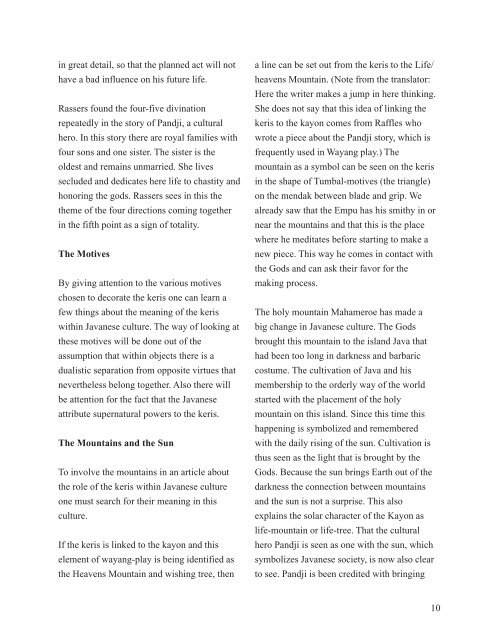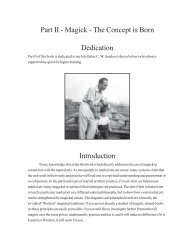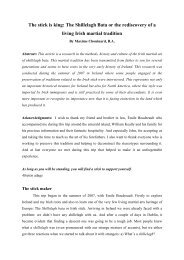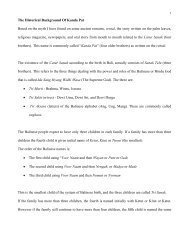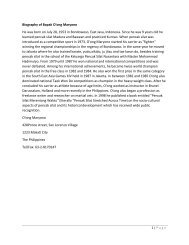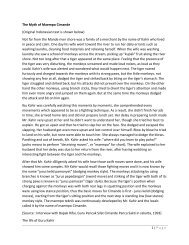Tenaga Dalam - Pukulan Cimande Pusaka
Tenaga Dalam - Pukulan Cimande Pusaka
Tenaga Dalam - Pukulan Cimande Pusaka
You also want an ePaper? Increase the reach of your titles
YUMPU automatically turns print PDFs into web optimized ePapers that Google loves.
in great detail, so that the planned act will not<br />
have a bad influence on his future life.<br />
Rassers found the four-five divination<br />
repeatedly in the story of Pandji, a cultural<br />
hero. In this story there are royal families with<br />
four sons and one sister. The sister is the<br />
oldest and remains unmarried. She lives<br />
secluded and dedicates here life to chastity and<br />
honoring the gods. Rassers sees in this the<br />
theme of the four directions coming together<br />
in the fifth point as a sign of totality.<br />
The Motives<br />
By giving attention to the various motives<br />
chosen to decorate the keris one can learn a<br />
few things about the meaning of the keris<br />
within Javanese culture. The way of looking at<br />
these motives will be done out of the<br />
assumption that within objects there is a<br />
dualistic separation from opposite virtues that<br />
nevertheless belong together. Also there will<br />
be attention for the fact that the Javanese<br />
attribute supernatural powers to the keris.<br />
The Mountains and the Sun<br />
To involve the mountains in an article about<br />
the role of the keris within Javanese culture<br />
one must search for their meaning in this<br />
culture.<br />
If the keris is linked to the kayon and this<br />
element of wayang-play is being identified as<br />
the Heavens Mountain and wishing tree, then<br />
a line can be set out from the keris to the Life/<br />
heavens Mountain. (Note from the translator:<br />
Here the writer makes a jump in here thinking.<br />
She does not say that this idea of linking the<br />
keris to the kayon comes from Raffles who<br />
wrote a piece about the Pandji story, which is<br />
frequently used in Wayang play.) The<br />
mountain as a symbol can be seen on the keris<br />
in the shape of Tumbal-motives (the triangle)<br />
on the mendak between blade and grip. We<br />
already saw that the Empu has his smithy in or<br />
near the mountains and that this is the place<br />
where he meditates before starting to make a<br />
new piece. This way he comes in contact with<br />
the Gods and can ask their favor for the<br />
making process.<br />
The holy mountain Mahameroe has made a<br />
big change in Javanese culture. The Gods<br />
brought this mountain to the island Java that<br />
had been too long in darkness and barbaric<br />
costume. The cultivation of Java and his<br />
membership to the orderly way of the world<br />
started with the placement of the holy<br />
mountain on this island. Since this time this<br />
happening is symbolized and remembered<br />
with the daily rising of the sun. Cultivation is<br />
thus seen as the light that is brought by the<br />
Gods. Because the sun brings Earth out of the<br />
darkness the connection between mountains<br />
and the sun is not a surprise. This also<br />
explains the solar character of the Kayon as<br />
life-mountain or life-tree. That the cultural<br />
hero Pandji is seen as one with the sun, which<br />
symbolizes Javanese society, is now also clear<br />
to see. Pandji is been credited with bringing<br />
10


